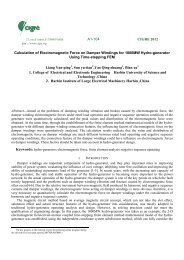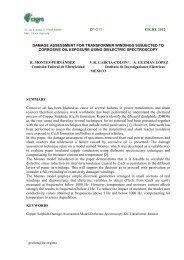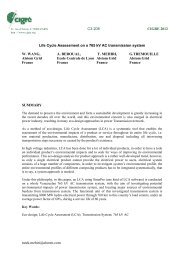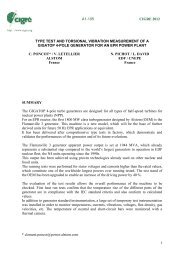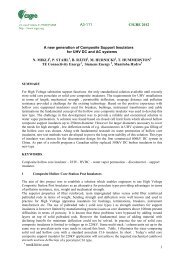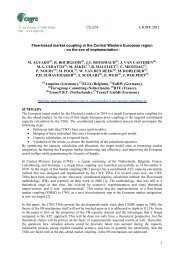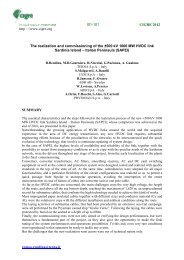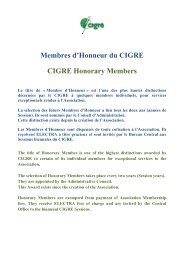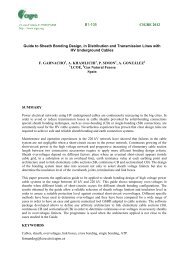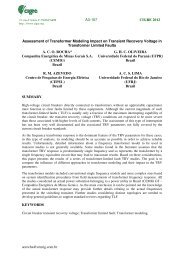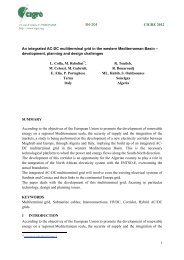etienne.veilleux@ieee.org Multi-Terminal HVDC Grid with ... - Cigre
etienne.veilleux@ieee.org Multi-Terminal HVDC Grid with ... - Cigre
etienne.veilleux@ieee.org Multi-Terminal HVDC Grid with ... - Cigre
You also want an ePaper? Increase the reach of your titles
YUMPU automatically turns print PDFs into web optimized ePapers that Google loves.
21, rue d’Artois, F-75008 PARIS B4-301 CIGRE 2012http : //www.cigre.<strong>org</strong><strong>Multi</strong>-<strong>Terminal</strong> <strong>HVDC</strong> <strong>Grid</strong> <strong>with</strong> Power Flow ControllabilityÉ. VEILLEUX and B.-T. OOIMcGill UniversityCanadaSUMMARYThe concept of developing <strong>Multi</strong>-<strong>Terminal</strong> <strong>HVDC</strong> (MTDC) grid has re-emerged in the recentyears <strong>with</strong> the increasing presence of renewable energy generation and the need for alternativepower routes. This paper introduces the concept of the dc power flow controller. With theaddition of dc power flow controller, a MTDC grid has increased its control flexibilitieswhich allow the line currents to be regulated and the power flow to be better managed. Theregion of operation for a 3-<strong>Terminal</strong> <strong>HVDC</strong> grid is evaluated to confirm the benefit of the dcpower flow controller. The topology used for this converter is a dual thyristor-bridgeconfiguration that gives four-quadrant operation. Finally, a 7-<strong>Terminal</strong> <strong>HVDC</strong> grid <strong>with</strong> a dcpower flow controller is simulated to confirm proper operation. Each terminal is modeled<strong>with</strong> a voltage-source converter (VSC) and its respective control diagram.KEYWORDSdc grid, multi-terminal <strong>HVDC</strong>, voltage-source converter, thyristor converter<strong>etienne</strong>.<strong>veilleux@ieee</strong>.<strong>org</strong>
1. INTRODUCTIONThe concept of developing <strong>Multi</strong>-<strong>Terminal</strong> <strong>HVDC</strong> (MTDC) grid has re-emerged in the recentyears <strong>with</strong> the increasing presence of renewable energy generation and the need for alternativepower routes. Unlike ac transmission, <strong>HVDC</strong> transmission is not hampered by large inductivereactive power in the long over-head lines or large capacitive reactive power in submarine orunderground cables. Moreover, self-commutated converter, such as voltage-source converter(VSC) and multilevel modular converter (MMC), permits the integration into weak ac system.These converters are more suitable for MTDC grid because they can change power flowdirection by simply changing current direction instead of voltage polarity [1].In order to implement such MTDC grid, some challenges still need to be addressed and to besolved. One of the major issues is the deficiency in degrees of freedom to control the powerflow as it has been pointed out in [2]. For example, an MTDC grid <strong>with</strong> three terminals andthree transmission lines, as shown in Figure 1, does not allow the regulation of each linecurrent individually. The cause of this condition is that dc line current depends only on thevoltage difference and the line resistance.Using the example of Figure 1, the dc line current of line L1 can be regulated by settingterminal V1 and V3. Similarly, the dc line current of line L2 can be set by regulating V2 andusing V3. Therefore, the current in line L3 is a direct consequence of the already selected V1and V2. In this system, it is not possible to regulate all three line currents. A suitable MTDCgrid should offer enough flexibility to control the power flow <strong>with</strong>out imposing limitations onthe number of transmission lines connected to a terminal.Power flow strategies have been suggested and demonstrated for MTDC grid using droopcontroller [3]. The strategy is suitable for small scale system but it would be more complex toimplement in an MTDC grid <strong>with</strong> significant number of terminals. Power flow controls in aMTDC grid <strong>with</strong> many terminals are also discussed in [4] and [5]. In [4], requirements areestablished such as individual operating points for terminals.The pillar in a MTDC grid is the dc voltage regulator terminal because it ensures powerbalance in the <strong>HVDC</strong> grid. It is the terminal that maintains the <strong>HVDC</strong> grid voltage to its ratedvalue. Typically, only one terminal is allowed to fulfill this role, otherwise, instability mayoccur as discussed in [4]. There are also concerns for the N-1 transmission reliability and theredundancy in the dc voltage regulator. With a dc power flow controller, it is possible to meetsome of these challenges.Figure 1: 3-<strong>Terminal</strong> <strong>HVDC</strong> grid.2
This paper introduces the concept of the dc power flow controller. The objective is todemonstrate that <strong>with</strong> the addition of dc power flow controller, a MTDC grid has increased itscontrol flexibilities which allows the line currents to be regulated and the power flow to bemanaged.Section 2 describes the concept and the requirements of the dc power flow controller. InSection 3, the regions of operation of a 3-terminal <strong>HVDC</strong> grid <strong>with</strong> and <strong>with</strong>out the controllerare evaluated to illustrate the benefit of such equipment. The dc power flow controllertopology is described in Section 4. Section 5 looks at a 7-<strong>Terminal</strong> <strong>HVDC</strong> grid. The N-1transmission line criterion along <strong>with</strong> the redundancy of a dc voltage regulator on a 7-terminal<strong>HVDC</strong> grid is discussed. The 7-terminal <strong>HVDC</strong> grid is modeled and simulated on a multicoresimulation platform. The conclusion is in Section 6.2. DC POWER FLOW CONTROLLERThe dc power flow controller is a voltage source (<strong>with</strong> either positive voltage or negativevoltage) which is inserted in series in the dc transmission line as shown in Figure 2. By doingso, the net voltage output of the <strong>HVDC</strong> terminal is given as:V +1= V 1V X(1)where V 1 is the dc voltage at the terminal and V X is the dc voltage contribution from the dcpower flow controller. From Figure 2, the current of line 1 depends on V 1 only. Incomparison, the current in line 3 relies on V 1 +V X . By adjusting V X , it is then possible to haveindependent control over the current flowing in line 3.The relatively low resistance of the transmission lines makes the line current highly sensitiveto voltage variations. Therefore, the range of V X can be in the range less than 5% of the<strong>HVDC</strong> grid rated voltage. Consequently, the controller needs to be rated for only a fraction ofthe terminal converter rating. The controller has to be able to operate in the four quadrants ofoperation. In other words, it should be capable of injecting either positive or negative voltagebut it has also to do it <strong>with</strong> the current flowing in either direction.The dc power flow controller is considered as an auxiliary component of a <strong>HVDC</strong>-station ofthe terminal. A transformer <strong>with</strong> low power rating is used to provide a galvanic isolation tothe power electronics components included in the controller as shown in Figure 2.Figure 2: <strong>HVDC</strong> terminal <strong>with</strong> the dc power flowcontroller. Example of <strong>Terminal</strong> 1 of Figure 1.3
3. REGION OF OPERATIONFigure 3 : 3-<strong>Terminal</strong> <strong>HVDC</strong> grid <strong>with</strong> the dcpower flow controller.Table 13-<strong>Terminal</strong> <strong>HVDC</strong> <strong>Grid</strong>Transmission Line ParametersLineResistance[Ω]Currentlimit[kA]1 3 0.52 1 0.53 2 0.25A MTDC grid <strong>with</strong> 3 terminals is developed to evaluate the benefit of the controller on asmaller scale system. The initial grid is as shown in Figure 1 and the line parameters <strong>with</strong>their respective current limits are given in Table 1. The mode of control for terminals 1 and 2are power injection <strong>with</strong> P 1 and P 2 respectively. <strong>Terminal</strong> 3 operates as the dc voltageregulator at 300kV. The region of operation of this grid is shown in Figure 4 as the blackregion. The region of operation is determined by the operating points (P 1 , P 2 ) that do notexceed the line current limits. The analysis considers only power injection, positive power,from terminals 1 and 2 into the dc grid. The dc voltage regulator extracts the power and itcovers transmission line losses.The MTDC grid is upgraded <strong>with</strong> a dc power flow controller installed on line 3 as shown inFigure 3. The controller is able to inject ±5kV. By doing so, the region of operation isenlarged by 109% as shown <strong>with</strong> the gray region of Figure 4.250200Region of OperationWith ControllerWithout Controller1I L1Transmission Line CurrentsP2 - [MW]150100Current - [kA]0.50I L250-0.5I L300 50 100 150 200 250P1 - [MW]Figure 4: Region of operation for a MTDC<strong>with</strong> 3 terminals and 3 lines.-5 0 5V X- [kV]Figure 5: Current variations <strong>with</strong> respect toV X for P 1 =150MW andP 2 =100MW.4
It is also possible to observe the current sensitivity <strong>with</strong> respect to the injected voltage V X . Forexample, Figure 5 shows the current variation when the system operates <strong>with</strong> P 1 =150MW andP 2 =100MW. Therefore, it is possible to identify the range of V X required to maintain thetransmission currents <strong>with</strong>in their limits for a given operating point. These results illustratethe benefits of such controller in a MTDC grid.4. CONTROLLER TOPOLOGYFigure 6: DC power flow controller topology based on thyristor-bridges.As shown in Figure 2, the dc power flow controller is inserted in series on the dc transmissionline. As a result, robustness of the converter is required to <strong>with</strong>stand large dc fault current thatcan appear on the line. For this reason, a thyristor-based converter topology has been selected.A back-to-back arrangement of two unidirectional thyristor-bridges is presented in Figure 6.More details of this 4-quadrant converter appear in [6].The injected voltage depends on the firing angle α of the thyristor-bridge. By neglecting thedc reactors L dir , L inv and L DC , the relationship for V X can be approximate as, [7]:3 2V X = V AC cos( α)(2)πwhere V AC is the rms value of the line-to-line voltage. The inductances L dir , L inv and L DC areinstalled to reduce the ripples created by the thyristor-bridge. If the current is positive <strong>with</strong>respect to the direction given by I DC in Figure 6, the thyristor-bridge “direct” is activated. Thevoltage injection will be positive for 0° ≤ α ≤ 90° and negative for 90° ≤ α ≤ 180°. If thecurrent is in the opposite direction, the thyristor-bridge “inverse” is activated and the voltageinjection will be negative for 0° ≤ α ≤ 90° and positive for 90° ≤ α ≤ 180°. By satisfyingEquation (3), both thyristor-bridges are creating the same voltage [6]. Based on the currentdirection, only one of the two thyristor-bridges is activated during the operation of the dcpower flow controller. The control diagram is shown in Figure 7.180 α° = α dir + inv(3)5
Figure 7: Control diagram for the thyristor-based dc power flow controller.5. 7-TERMINAL <strong>HVDC</strong> GRIDT1VSCI L12T2VSCI L23T3VSCT6VSCI L46T4VSCI L47I L45T5VSCT7VSCFigure 8: 7-<strong>Terminal</strong> <strong>HVDC</strong> grid configuration.5.1 DescriptionThe MTDC grid under study consists of 7 VSC-<strong>HVDC</strong> stations, identified as T1 to T7, andthey are interconnected as shown in Figure 8. Stations T1 and T6 are selected to representoffshore wind farms. The other terminals are onshore terminals stations. The grid structureoffers redundancy which contributes to satisfy the N-1 criterion. For redundancy, terminalsT2 and T5 are selected to be the dc voltage regulators. The rated voltage level of this MTDCgrid is selected to be 300kV. The dc voltage regulators also serve as power slacks providingautomatic dc power balance in the dc grid including transmission losses. All other terminalsof the <strong>HVDC</strong> grid, including offshore wind farm terminals T1 and T6, are performing powercontrol in this case study. The control reference for the VSC of each terminal is given inTable 2. A positive power refers to power injection to the dc grid as opposed to a negativevalue refers to power extraction from the dc grid. The transmission lines parameters are takenfrom [8] and it is given Table 3. The maximum current is selected arbitrary between a “light”line (maximum current of 0.5kA) and “heavy” line (maximum current of 1kA).For the control references of Table 2, the operation of the MTDC grid under study, <strong>with</strong>out adc power flow controller, the solution of line current flows and converter powers issummarized in Figure 9(a). It can be noted that terminal T2, a dc voltage regulator, has toextract 253MW in order to maintain the power balance while terminal T5 should inject56MW. The power 253MW may be too large for T2 whereas T5 is underutilized.6
T1+200MW0.66kA-253MWT2300kV0.1kA0.28kA0.21kAT3+150MWT1+200MW0.66kA-50MWT2300kVVx+2.3kV0.78kA0.28kA0.21kAT3+150MWT6+100MW0.33kAT4-200MW0.25kA0.02kA0.15kAT5300kV+56MWT6+100MW0.33kAT4-200MW0.32kA0.12kA0.05kA-147MWT5300kVT7-50MWT7-50MW(a)(b)Figure 9: Normal operation of the 7-<strong>Terminal</strong> <strong>HVDC</strong> grid: (a) <strong>with</strong>out dc power flowcontroller, (b) <strong>with</strong> power flow controllerWhen a dc power flow controller is inserted at terminal T2 on line L24, as shown in Fig. 9(b),it influences the power flow around terminal T2 such that the power extraction of terminal T2is reduced from -253 MW to -50MW. What was -253 MW in T2 is now shifted to T5 whichnow has to extract -147MW. The re-routing of dc power is evident by comparing the linecurrents in Fig. 9 (a) and (b). The VSCs at terminal T2 and T5 continue to perform dc voltageregulator at 300kV and it is V X of the dc power flow controller which diverts the power flow.The value of V X is +2.3kV. The other terminals are performing power injection based on theirreference values.Table 2: VSC control references<strong>Terminal</strong> Control Control referenceoperationT1 Power P rated = + 200MWT2 Voltage V rated = 300kVT3 Power P rated = + 150MWT4 Power P rated = - 200MWT5 Voltage V rated = 300kVT6 Power P rated = + 100MWT7 Power P rated = - 50MWTable 3: Transmission line parametersLines Distance[km]Resistance[Ω]Inductance[mH]Maximum current[kA]L12 413 5 43.6 1L23 248 3 26.2 0.5L24 207 2.5 21.9 1L35 331 4 35.0 1L45 83 1 8.76 0.5L46 207 2.5 21.9 0.5L47 289 3.5 30.5 0.5L57 165 2 17.4 0.57
(a)(b)Figure 10: 7-<strong>Terminal</strong> dc grid under different contingencies: (a) loss of a dc voltage regulatorterminal, (b) loss a dc transmission line.5.2 Redundancy in voltage regulatorThe presence of two dc voltage regulators, T2 and T5, makes the dc grid more reliable in caseof failure of one of the voltage reference terminals. For example, the loss of terminal T2allows the MTDC grid to operate normally and steady-state currents are shown in Figure10(a). For this scenario, it has been assumed that the VSC as well as the dc power flowcontroller are out of service but the dc connection remains for the transmission lines.However, it is important to note that in the situation depicted in Figure 10(a), terminal T5 hasto compensate for the loss of terminal T2. Therefore, it has to absorb the power that waspreviously extracted by terminal T2 in order to maintain power balance in the dc grid. Theoperation described inhere focuses on the ability of concurrent operation of two dc voltageregulators inside the same MTDC grid.5.3 N-1 ContingencyThe MTDC grid should be able to operate under the N-1 contingency requirement. Obviously,lines L12 and L46 are automatically excluded from this analysis since terminals T1 and T6represent offshore wind farm that are uniquely connected onshore. Therefore, six cases needto be analyzed to ensure normal operation under the interruption of dc lines: L23, L24, L35,L45, L47 or L57. The results for each scenario are listed in Table 4.A special consideration has to be made for the outage of line L24 (scenario 2). Since the dcpower flow controller V X is located on that line, its interruption results in the loss of thiscontrol variable in the system. As a result, the power flow cannot be redirected aroundterminal T2. If it is left as this, terminal T2 should extract 283MW and <strong>Terminal</strong> T5 has toinject 86MW. This is beyond the power rating of 50MW initially planned for terminal T2converter. Suggested solutions are: i) the installation of a second dc power flow controller online L23 for redundancy or ii) a change in the mode of operation of <strong>Terminal</strong> T2 under thiscircumstance only. <strong>Terminal</strong> T2 would change from dc voltage regulator to constant powerextraction of 50MW. The redundancy in the dc voltage regulator and the flexibility of theterminal control settings allow the MTDC grid to operate in this manner as shown in Figure10(b).8
In all scenarios, the transmission line currents remain <strong>with</strong>in the line limits. This analysisconfirms that the MTDC under study is capable of operating in agreement <strong>with</strong> the N-1criterion of a power system.Table 4: N-1 contingency scenariosScenarioVxTransmission line current [kA][kV] L23 L24 L35 L45 L47 L571 + 1.3 OUT 0.49 0.50 0.08 0.08 0.092* OUT 0.48 OUT 0.98 - 0.33 0.00 0.173 + 3.0 - 0.50 0.99 OUT 0.50 0.15 0.014 + 4.1 - 0.28 0.78 0.21 OUT 0.45 - 0.285 + 2.4 - 0.28 0.78 0.21 0.44 OUT 0.176 + 2.2 - 0.28 0.78 0.21 0.28 0.17 OUT*<strong>Terminal</strong> 2 control mode changes to constant power control5.4 Simulation resultsThe 7-terminal <strong>HVDC</strong> grid is implemented on a multi-core simulator called Opal-RT along<strong>with</strong> the related software package RT-LAB. The simulation platform uses theMATLAB/Simulink interface and simulations can be done either in real-time or offline [9].Parallel computation over multiple cores reduces significantly the simulation duration. In thispaper, the simulation is done offline and each terminal has been implemented on an individualcore. Each terminal is a composed of a complete VSC model along <strong>with</strong> their controllers asshown in Figure 11(a) and 11(b). In addition to the VSC, terminal T2 has the dc power flowcontroller based on the thyristor topology described in Section 4. The configuration is shownin Figure 12(a) and the control diagram is shown in Figure 12(b). The simulation results areshown in Figures 13 and 14.(a)(b)Figure 11: <strong>Terminal</strong> configuration: (a) VSC topology, (b) VSC control diagram(a)(b)Figure 12: <strong>Terminal</strong> T2 schematic: (a) configuration <strong>with</strong> the dc power flow controller, (b)control diagram of the thyristor-based dc power flow controller.9
250<strong>Terminal</strong> Powers303.5<strong>Terminal</strong> Voltage200P T1303V T1150100P T3P T6302.5Power - [MW]500-50P T7P T2Voltage - [kV]302301.5301V T6V T3-100-150-200P T5300.5300V T4V T5V T2P T4V T7-2500 2 4 6 8Time - [s](a)299.52 4 6 8Time - [s](b)Figure 13: 7-<strong>Terminal</strong> dc grid simulation results. (a) power injection/extraction, (b) terminaldc voltagesCurrent - [kA]0.80.60.40.2I L24I L12I L45I L35I L47Transmission Line CurrentFiring Angle - [degrees]DC Power Flow Controller1008060α dir4020α inv00 2 4 6 8Time - [s]2.5(b)0I L57-0.2I L23V X- [kV]21.5I-0.4 L460 2 4 6 8Time - [s](a)10 2 4 6 8Time - [s](c)Figure 14: 7-<strong>Terminal</strong> dc grid simulation results. (a) transmission line currents, (b) dc powerflow controller firing angle and (c) injected voltage Vx.10
The analysis of the results is divided into three segments. The first segment, ranging fromt=0s to t=2s, is the steady-state operation of the MTDC grid. It demonstrates the normaloperation conditions shown in Figure 9(b). <strong>Terminal</strong> powers, voltages and transmission linecurrents are shown in Figures 13(a), 13(b) and 14(a), respectively. <strong>Terminal</strong>s T2 and T5succeed to maintain their dc-side voltages at 300kV. All the other terminals regulate at theirpower reference values. The transmission line currents are in agreement <strong>with</strong> the theoreticalvalues shown in Figure 9(b). Figure 14 shows also two parameters of the dc power flowcontroller. Figure 14(b) shows the two firing angles of the dual converter. Since the currentnever changes direction, only one part of the dual-converter is operating. In this simulation,the “direct” thyristor-bridge is activated. The injected voltage V X , shown in Figure 14(c), isregulated at +2.3kV as initially calculated.The second segment is ranging from t=2s to t=5s. During this period, terminal T1 experiencesa reduction in its power production going from 200MW to 100MW. This is intended torepresent a decrease of production from an offshore windfarm. The dc power flow controllersucceeded to maintain the power extraction of terminal T2 at 50MW while terminal T2maintain the dc voltage at 300kV. <strong>Terminal</strong> voltage at T5 drops slightly during the transition.The dc voltage quickly resumes to 300kV at terminal T5 once the transition is over.The third segment consists of the new operating condition established after the new powercontribution from terminal T1. The segment ranges from t=5s to the end. The MTDC gridremains stable and all the other terminals continue to inject/extract as before. The main impactis on the power extracted from terminal T5 where it changes from 147MW to 47MW.This simulation demonstrates the operation of a 7-terminal <strong>HVDC</strong> grid where one terminaldecreases its power contribution by half over a 3 seconds range. The simulation resultsconfirm proper operation of the developed dc power flow controller inside the MTDC grid.6. CONCLUSIONThis paper has presented the concept of the dc power flow controller used in the context ofMTDC grid. A series module is inserted along a dc transmission line to control thetransmission current and, as a result, it influences the power flow among the dc grid. Theoperation and the benefits have been demonstrated by a simple 3-terminal <strong>HVDC</strong> grid. Aconverter topology based on thyristor has been presented to fulfill the role of the dc powerflow controller. Finally, a 7-terminal VSC-<strong>HVDC</strong> grid has been developed <strong>with</strong> an analysison the dc voltage regulator redundancy as well as on the N-1 contingency criterion. This 7-terminal <strong>HVDC</strong> grid <strong>with</strong> complete VSC models has been simulated on a multi-core platformto validate proper and stable operation.7. ACKNOWLEDGEMENTSThe authors would like to thank the research and development team of Opal-RT TechnologiesInc. for its technical support concerning the implementation on the multi-core simulator. Thelead author is supported by the Fonds Québécois de la Recherche sur la Nature et lesTechnologies (FQRNT) and the research is funded by a Discovery Grant of the NaturalScience and Engineering Council of Canada (NSERC).11
8. BIBLIOGRAPHY[1] F. Wang, L. Bertling, T. Le, A. Mannikoff and A. Bergman “An Overview Introductionof VSC-<strong>HVDC</strong>: State-of-art and Potential Applications in Electric Power Systems,” inCigré 2011 Bologna Symposium, 2011.[2] G. Asplund, “<strong>HVDC</strong> grids - possibilities and challenges,” in Cigré SC B4 2009 BergenColloquium, 2009.[3] L. Yao, L. Xu, M. Bazargan and R. Critchley, “<strong>Multi</strong>-terminal <strong>HVDC</strong> grid for networkinterconnection and renewable energy integration,” in Cigré 2010 Session 43, 2010.[4] G. Asplund, B. Jacobson, B. Berggen, and K. Lindén, “Continental Overlay <strong>HVDC</strong>-<strong>Grid</strong>,” in Cigré 2010 Session 43, 2010.[5] E.K. Chukaluri, C. Barker and R. King, “A study on some of the important aspectsrelated to feasibility of <strong>HVDC</strong> grid,” in Cigré 2011 Bologna Symposium, 2011.[6] P. Sen, Thyristors DC Drives, Wiley-Interscience, 1981.[7] J. Arrillaga, Y. Liu and N. Watson, Flexible Power Transmission: The <strong>HVDC</strong> Options,John Wiley & Sons, 2007.[8] D. Van Hertem, M. Ghandhari, J.B. Curis, O. Despouys and A. Marzin, “Protectionrequirements for a multi-terminal meshed DC grid,” in Cigré 2011 Bologna Symposium,2011.[9] RT-LAB Version 10.2 User Guide, Opal-RT Technologies, 2007.12



